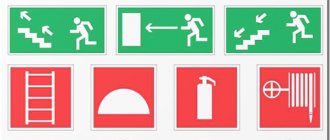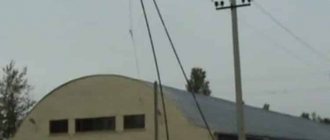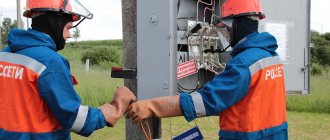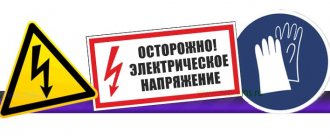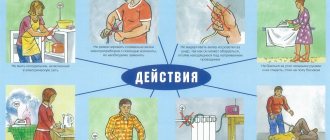Rate this article!
Let's be honest, we have never done this before. In each case, for a certain profession or type of work, there is its own instruction on labor protection. But this is a good experiment: why not? It is very interesting to look at a short general safety briefing.
So, let's agree on the following: to make the instructions really brief, we will give in it only those provisions that can be found in each instruction. Then such instruction can be carried out with literally everyone. Let's begin!
Who should be trained
According to clause 2.1.1 of the Procedure, all persons hired for work must undergo training. It is also mandatory for employees who are transferred to another job.
REFERENCE
Is safety training necessary for a person who is not on the company’s staff, but performs work or provides services under a civil contract? The answer depends on the terms of the contract. If it states that the customer pays insurance premiums “for injuries” for the contractor (performer), then training should be carried out. This opinion was expressed by the Ministry of Labor in letter No. PG/02487-6-1 dated February 21, 2020 (see “Labor safety: is it necessary to instruct workers with whom GPC agreements have been concluded?”).
Instructions
Basic requirements for TB:
- when starting to perform each type of work that has not been done before, additional instruction is needed;
- extreme attentiveness is required, it is not recommended to be distracted by extraneous conversations or affairs;
- On the territory of the plant you cannot walk around the workshops, ignore the signals of crane operators and vehicle drivers. It is imperative to bypass unloading and loading areas, and bypass places not intended for passage. You cannot touch terminals, electrical wires, equipment, fittings, lighting devices, especially with tools or scissors;
- In case of injury or any ailment, the injured person needs to stop the work process and seek medical help.
Workers perform various operations at the site
Before starting to perform direct work duties, employees must get their uniform in order, put on personal protective equipment, if necessary, and special shoes. You should also inspect the workplace, restore order, and remove unnecessary items. There should be enough light, but not blinding to the eye, it should be directed towards the work area.
It is necessary to inspect the floor - there should be no potholes, slippery areas or other defects. Hoists and hoists can only be used in good working order. When moving or lifting heavy loads, the signal must be given by one worker. The slinging is made reliable; high-strength cleats are used for mooring.
Sharpening tools on grinding wheels can only be done by first wearing safety glasses. There is a protective screen; it should not be moved to the side. Be sure to check that the tool rest is installed correctly and bring it as close to the grinding wheel as possible. You need to stand half a turn towards the wheel while sharpening. You cannot remove chips by hand.
Who conducts on-the-job training?
Depends on the type of instruction:
- the induction is carried out by an occupational safety specialist (see “How to become an occupational safety specialist”), or another employee who is assigned such responsibilities by order of the manager;
- primary, repeated, unscheduled and targeted are carried out by the one who supervises the work: foreman, foreman, teacher, etc. It is necessary that this person undergo occupational safety training at an accredited training center or at an enterprise if a commission has been created there to test knowledge of occupational safety requirements (for more details, see “Procedure for occupational safety training at an enterprise in 2022: terms, rules, organization”) .
Complete training and receive a certificate of occupational safety specialist Submit an application
Responsible persons
Occupational health and safety in hot and cold workshops
The safety of workers, in addition to themselves, must be taken care of by the security service and the employer.
What an employer must
A superficial acquaintance with occupational safety and health may lead to the idea that the occupational health and safety engineer is responsible for the safety of employees. This is not true - the main responsible person will be the immediate supervisor. The corresponding responsibilities are assigned to management at different levels - departments, divisions, enterprises.
OT service
The OT service is organized specifically to solve problems such as:
- conducting investigations, analyzing the causes of accidents;
- creation and implementation of programs and activities aimed at improving working conditions;
- organizational, methodological support;
- participation in knowledge testing;
Security service guarding the rules
- assistance in preparing papers on occupational health and safety issues;
- compiling lists for the provision of food, protective clothing, payment of benefits, and undergoing regular medical examinations;
- preparation and submission of reports;
- storage of documentation;
- organization of training;
- regular inspections of the health status within departments;
- conducting introductory briefings.
Service specialists have the right to inspect premises, equipment and machinery at any necessary time, look at documents, and monitor the process of work performed by workers.
Important! To successfully solve current problems, OT specialists cooperate with various enterprise services, commissions, and trade unions.
Who monitors the services?
Occupational safety specialists report to the head or deputy head of the company in which they work. Representatives of third-party organizations are required for professional monitoring of the quality of performance of duties. These include departmental, state, non-departmental, and public bodies. Inspections are carried out as planned, and the OT service is properly notified of the activities provided.
What types of safety training are there?
Introductory training on occupational safety
Needed by everyone who got a job or came on a business trip. Also, apprentices and students in practice, as well as people from third-party organizations involved in the company’s production activities, are required to undergo induction training.
Initial briefing on labor protection and safety in the workplace
It is intended for all newly hired workers, including seasonal workers and those who have signed an employment contract for less than two months.
Primary training is also given to:
- part-time workers;
- homeworkers using materials, tools or machinery;
- employees transferred from other structural units;
- persons who are entrusted with a new job;
- those who came on a business trip from other organizations;
- trainees;
- everyone who in one way or another participates in the production activities of the company.
ATTENTION
The employer has the right to approve a list of professions and positions exempt from initial instruction.
The list can include workers not involved in the operation, maintenance, testing, adjustment and repair of equipment. It is permissible to include in it those who do not use electrified and other tools, do not store or use raw materials. Compose HR documents using ready-made templates for free
Repeated safety briefing
Necessary for everyone who attended the initial training. Repeated events are held regularly.
Unscheduled briefing on labor protection
Needed in case:
- changes or introduction of new laws and other regulatory legal acts on labor protection, instructions on occupational safety;
- changes in technological processes, replacement or modernization of equipment, devices, tools and other factors affecting labor safety;
- violation by employees of occupational safety requirements if there is a real threat of serious consequences: accident, breakdown, etc.;
- requirements of officials of state supervision and control bodies;
- a break in work for more than two months (for work with harmful and (or) dangerous conditions - more than 30 calendar days);
- the employer making an appropriate decision.
Targeted training on labor protection
It is suitable for performing one-time work and holding public events. Other reasons for targeted training are liquidation of the consequences of accidents and natural disasters; work that requires a work permit, permit or other special document.
Definition of the concept
Safety precautions are a set of organizational and technical measures that are needed to create safe working conditions and that prevent industrial accidents. She determines the internal organizational routine and is responsible for ensuring that the process of conducting professional activities is as trouble-free as possible. At factories and in other organizations, to solve problems, entire services are organized under the department of the chief engineer, developing measures aimed at ensuring safe operating conditions.
Prohibition sign and safety precautions: you can’t do this
It is mandatory to systematically carry out specialized measures aimed at reducing the risk of injury and eliminating the likelihood of industrial accidents. Such activities boil down mainly to:
- improvement and modification of the designs of existing equipment to protect employees from injury;
- installation of new, modification of old designs of existing protection devices for machine tools, machines, heating installations;
- improvement of working conditions - creation of sufficient lighting, ventilation system, arrangement of dust extraction, timely elimination of production waste, maintaining optimal temperature inside the workshops;
- eliminating the risks of developing emergency situations during equipment operation, breaking grinding wheels, minimizing the risks of acid splashing, etc.;
- organized briefing of newcomers regarding the rules of behavior on the territory of the enterprise, training, testing of knowledge;
- provision of TB instructions and posters in sufficient quantities.
Accidents are still possible, largely due to workers ignoring the safety precautions for operating power plants, electrical installations, and other equipment. The relevant issues should be covered by the responsible person during the scheduled briefing. Physically outdated facilities should undergo regular inspections and updates. Responsible specialists monitor compliance with the system of rules and regulations - they are the ones who must teach the basics of proper work.
Important! Particular caution is needed in construction and areas with other high risks.
Workers who deal with welding stations, solvents in production, and other dangerous tools and materials must have an appropriate knowledge base on the practice of conducting basic operations.
Contents of the safety briefing
Clause 2.1.3 of the Procedure states that during the briefing the employee becomes familiar with dangerous or harmful production factors. In addition, he studies: local regulations of the organization, safety instructions, technical and operational documents, safe methods and techniques for performing work.
For introductory and initial training, special programs approved by the employer are needed. They are developed taking into account the specifics of the enterprise, safety instructions, technical and operational documentation.
At the end of the training, the person conducting the training verbally checks what knowledge and skills the employee has acquired.
Retrain and improve your skills in the field of labor protection
Responsibility for violation of safety rules
Responsibility for violation of safety rules can be assigned to the manager, the safety service, or employees. Appointed officials are primarily responsible. Employees are directly responsible for violation of safety rules, as for violation of labor discipline (with the exception of criminal liability).
Responsibility may be:
- administrative and criminal , depending on the severity of the consequences and the intentionality of failure to comply with the instructions;
- disciplinary;
- material.
The resulting administrative liability provides for fines in various monetary amounts.
Disciplinary liability includes demotion , reprimand, reprimand, removal from a position for a certain period or temporary or complete removal from duties in whole or in part.
Financial liability is expressed in compensation for damage caused by careless handling of entrusted property, resulting in its damage or in the event of theft of property. Issues that arise can be resolved on the spot between the employee and management or through the court. Recovery can be carried out in whole or in part by deducting small amounts from wages.
Criminal liability arises in situations where, through the fault of an employee, another person is injured, as a result of which he becomes disabled or dies.
Responsibility for violation of labor protection rules - Article 143 of the Criminal Code of the Russian Federation
Timing of H&S briefings
For clarity, we have summarized them in a table:
| Type of instruction | Dates |
| Introductory | before the initial briefing |
| Primary | before starting independent work |
| Repeated | at least once every 6 months |
| Unscheduled | if necessary |
| Target |
Rules for conducting and completing workplace training
There are two types of training that always take place in the workplace.
- Primary
- Repeated
Sometimes unscheduled events are organized at the workplace. This happens if the reason is innovations directly related to the workshop, conveyor belt, etc. For example, changing technological processes or upgrading machines.
In all other cases (if the basis for the briefing is changes in the law, the requirements of the inspector, etc.), an unscheduled briefing can be carried out away from production - in the hall, assembly hall, etc.
IMPORTANT
There is a form for registering on-the-job training.
It is listed in GOST 12.0.004-2015 (approved by order of Rosstandart dated 06/09/16 No. 600-st). But the use of this GOST is voluntary. Therefore, organizations and individual entrepreneurs have the right to develop their own form of journal. Prepare labor safety documents in a special service Try for free
Employer Responsibilities
The employer must fulfill his responsibilities directly in terms of occupational safety, which include:
- provide employees with Codes, legal acts, laws;
- select and approve the staff of the labor protection service;
- create and approve a system for the functioning and management of the labor protection service;
- together with the responsible persons, he must develop safety instructions for each staff unit and develop programs;
- safety instructions are created for each full-time position available at the enterprise;
- create a workplace and a thematic office for the labor protection service, ensure the availability of visual aids and safety materials if necessary.
In addition, the employer is obliged to provide employees not only with training material, visual aids, illustrations, etc., but also to organize workplaces according to requirements, provide them with special clothing, and organize a rest room if necessary. The employer is obliged to personally monitor the health status of employees and take measures for treatment, prevention and recovery.
OT office
Features of conducting labor safety briefings
Do remote workers and homeworkers need to be instructed? Yes need. After all, the working conditions of a homeworker must comply with labor safety requirements (Article 311 of the Labor Code of the Russian Federation). And remote employees must be trained in safe methods of working with equipment and tools that are recommended or provided by the employer (Article 312.7 of the Labor Code of the Russian Federation). Also see “Remote work in 2021, read the new law on remote work.”
All types of training, including initial training, are required for office staff. The fact is that exemption can only be given to those who do not deal with the equipment. Whereas office workers use computers. Therefore, they must undergo initial training.
Potential risk of the construction industry
Construction is a rather complex area both in terms of the use of resources and in its structure. This type of work activity involves the creation, modification or dismantling of an object and includes the following types of work:
- design;
- research;
- construction and installation;
- commissioning;
- organizational;
- coordination with authorized bodies.
This area is characterized by many factors that can cause injury, even death, or cause occupational disease. As their concentration increases, the degree of risk increases significantly. These factors include:
- moving mechanisms and their parts;
- the possibility of falling materials, raw materials, equipment, parts of structures during dismantling, etc.;
- high-altitude work;
- gas pollution, dustiness;
- excessively high or low air temperature;
- inappropriate air humidity;
- risk from electricity;
- adversely affecting substances, including toxic and chemical ones;
- heavy physical activity;
- neuropsychic stress.
REFERENCE! In the construction industry, the risk of adverse consequences at each stage of activity is several times higher than in other economic sectors.
Registration of labor safety briefings
To record briefings, a log is used, and in some cases, a work permit is used. The date of the knowledge test should be indicated, as well as the signatures of the instructor and the person who attended the course (clause 2.1.3 of the Procedure).
GOST 12.0.004‑2015 contains three recommended forms of logs: for introductory, for targeted instruction and for on-the-job instruction. You can use them or develop your own forms.
REFERENCE
The Ministry of Labor, in letter No. 15-2/OOG-1744 dated July 16, 2018, stated that it is not necessary to lace up magazines, number pages, and put a stamp. But the employer has the right to establish such requirements and enshrine them in local regulations on office work.
Magazines
In accordance with current legislation, logs for registering briefings at workplaces are filled out in accordance with the established form. They record all types of work performed. The employer monitors the availability and correctness of the document. If there is no log, employees of regulatory authorities may accuse management of non-compliance with labor safety rules.
Important! The journal is certified by the responsible person. The type of document production is typographic.
The filling form is used uniformly for all divisions of the company. The forms are kept by an engineer or other responsible employee. The specialist who conducts the instructions can take the log from the occupational safety engineer. The pages of the document are numbered, laced, and stamps are required.


